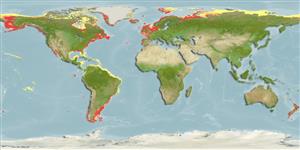Common names from other countries
Environment: milieu / climate zone / depth range / distribution range
Ecología
Pelágico; rango de profundidad 0 - 102 m (Ref. 120471). Polar
Distribución
Países | Áreas FAO | Ecosistemas | Ocurrencias, apariciones | Introducciones
Arctic, Northern Atlantic and Pacific Ocean.
Length at first maturity / Tamaño / Peso / Age
Maturity: Lm ? range ? - ? cm Max length : 1.4 cm WD macho / no sexado; (Ref. 2992)
Coastal species, estuarine; weak swimmer; feeds on copepods, polychaete larvae and fish larvae (Ref. 2376). Meroplanktonic (Ref. 120471).
Life cycle and mating behavior
Madurez | Reproducción | Puesta | Huevos | Fecundidad | Larva
Species exhibits both asexual and sexual reproduction by budding during hydroid stage and release of gametes in medusae stages (Ref. 1663, p. 18, 26).
Cairns, S.D., D.R. Calder, A. Brinckmann-Voss, C.B. Castro, D.G. Fautin, P.R. Pugh, C.E. Mills, W.C. Jaap, M.N. Arai, S.H.D. Haddock and D.M. Opresko. 2003. (Ref. 1663)
IUCN Red List Status (Ref. 130435)
CITES status (Ref. 108899)
Not Evaluated
Not Evaluated
Human uses
| FishSource |
Herramientas
Más información
Age/SizeCrecimientoLength-weightLength-lengthMorfologíaLarvaAbundancia
Fuentes de Internet
Estimates based on models
Preferred temperature
(Ref.
115969): 5.7 - 12.4, mean 9.1 (based on 948 cells).
Vulnerability
Low vulnerability (10 of 100).
Price category
Unknown.
